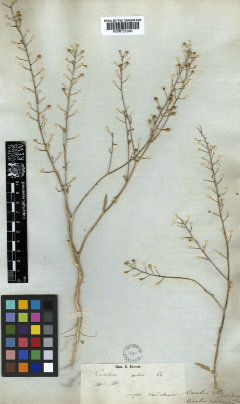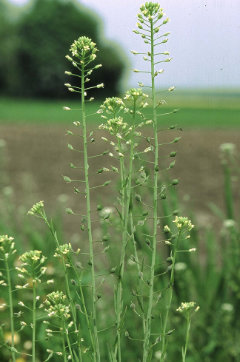 |
|
A specimen from Kew's Herbarium |
 |
| Camelina species. CC BY-SA 3.0, https://commons.wikimedia.org/w/index.php?curid=512000 |
Translate this page:
Summary
Camelina, a genus in the Brassicaceae family, includes species known as false flax, native to Mediterranean regions of Europe and Asia. Most species are not well-studied, except for Camelina sativa, historically used as an oil plant. In 2010, the US Navy tested a 50-50 mix of jet aviation fuel and biofuel derived from camelina sativa seeds to reduce fossil fuel emissions (Camelina rumelica may have similar uses). However, a 2016 study highlighted that the low cost of conventional kerosene-based jet fuel makes camelina-based jet fuel economically unfeasible for commercial airlines. The study suggested that substantial government intervention, including a 9 percent subsidy on camelina crop production and a 9 percent tax on conventional fuel, could help create a market for camelina.
Physical Characteristics

 Camelina rumelica is a ANNUAL growing to 0.4 m (1ft 4in) by 0.1 m (0ft 4in) at a fast rate.
Camelina rumelica is a ANNUAL growing to 0.4 m (1ft 4in) by 0.1 m (0ft 4in) at a fast rate.
See above for USDA hardiness. It is hardy to UK zone 6 and is not frost tender. The flowers are pollinated by Insects.
Suitable for: light (sandy), medium (loamy) and heavy (clay) soils and prefers well-drained soil. Suitable pH: mildly acid, neutral and basic (mildly alkaline) soils. It cannot grow in the shade. It prefers dry or moist soil.
UK Hardiness Map
US Hardiness Map
Synonyms
Homotypic Synonyms: C. sativa subsp. rumelica (Velen.) O.Bolòs & Vigo. Accepted Infraspecifics: C. rumelica subsp. rumelica.
Plant Habitats
Edible Uses
A wild edible green containing unusually high potassium levels. A genetically modified form of Camelina sativa (not Camelina rumelica) has been developed to produce Eicosapentaenoic acid (EPA) and Docosahexaenoic acid (DHA) at levels comparable to fish oil. EPA and DHA are long-chain omega-3 fatty acids beneficial for cardiovascular health. Traditionally sourced from fish, these omega-3 fatty acids face limitations and sustainability concerns [2-4] .
References More on Edible Uses
Medicinal Uses
Plants For A Future can not take any responsibility for any adverse effects from the use of plants. Always seek advice from a professional before using a plant medicinally.
None known
References More on Medicinal Uses
The Bookshop: Edible Plant Books
Our Latest books on Perennial Plants For Food Forests and Permaculture Gardens in paperback or digital formats.

Edible Tropical Plants
Food Forest Plants for Hotter Conditions: 250+ Plants For Tropical Food Forests & Permaculture Gardens.
More

Edible Temperate Plants
Plants for Your Food Forest: 500 Plants for Temperate Food Forests & Permaculture Gardens.
More

More Books
PFAF have eight books available in paperback and digital formats. Browse the shop for more information.
Shop Now
Other Uses
References More on Other Uses
Cultivation details
An annual or biennial weed. Flowering May to Jun (Northern Hemisphere). Elevations of 100–1500m. Flower colour: yellow. No nitrogen-fixing symbionts.
References Carbon Farming Information and Carbon Sequestration Information
Temperature Converter
Type a value in the Celsius field to convert the value to Fahrenheit:
Fahrenheit:
The PFAF Bookshop
Plants For A Future have a number of books available in paperback and digital form. Book titles include Edible Plants, Edible Perennials, Edible Trees,Edible Shrubs, Woodland Gardening, and Temperate Food Forest Plants. Our new book is Food Forest Plants For Hotter Conditions (Tropical and Sub-Tropical).
Shop Now
Plant Propagation
Seed.
Other Names
If available other names are mentioned here
Romanian Gold-of-Pleasure. German: Saat-Leindotter. Austria: Balkanischer Leindotter. Sweden: balkand'dra.
Native Range
Native to: Afghanistan, Albania, Bulgaria, Cyprus, Egypt, Greece, Iran, Iraq, Kirgizstan, Krym, Lebanon-Syria, North Caucasus, Pakistan, Romania, Tadzhikistan, Transcaucasus, Turkey, Turkey-in-Europe, Turkmenistan, Ukraine, Uzbekistan, Croatia, Montenegro, Serbia, Slovenia, Bosnia and Herzegovina, and Macedonia.
Weed Potential
Right plant wrong place. We are currently updating this section.
Please note that a plant may be invasive in one area but may not in your area so it's worth checking.
None Known
Conservation Status
IUCN Red List of Threatened Plants Status : This species has not yet been assessed for the IUCN Red List.

Growth: S = slow M = medium F = fast. Soil: L = light (sandy) M = medium H = heavy (clay). pH: A = acid N = neutral B = basic (alkaline). Shade: F = full shade S = semi-shade N = no shade. Moisture: D = dry M = Moist We = wet Wa = water.
Now available:
Food Forest Plants for Mediterranean Conditions
350+ Perennial Plants For Mediterranean and Drier Food Forests and Permaculture Gardens.
[Paperback and eBook]
This is the third in Plants For A Future's series of plant guides for food forests tailored to
specific climate zones. Following volumes on temperate and tropical ecosystems, this book focuses
on species suited to Mediterranean conditions—regions with hot, dry summers and cool, wet winters,
often facing the added challenge of climate change.
Read More
Expert comment
Author
Velen.
Botanical References
Links / References
For a list of references used on this page please go here
Readers comment
| Add a comment |
|
If you have important information about this plant that may help other users please add a comment or link below. Only comments or links that are felt to be directly relevant to a plant will be included. If you think a comment/link or information contained on this page is inaccurate or misleading we would welcome your feedback at [email protected]. If you have questions about a plant please use the Forum on this website as we do not have the resources to answer questions ourselves.
* Please note: the comments by website users are not necessarily those held by PFAF and may give misleading or inaccurate information.
To leave a comment please Register or login here All comments need to be approved so will not appear immediately.
|
Subject : Camelina rumelica
|
|
|
|